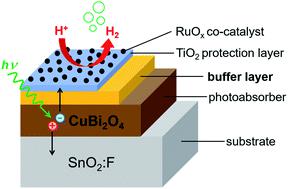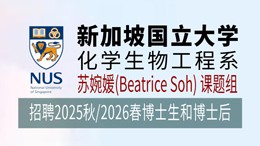当前位置:
X-MOL 学术
›
Chem. Sci.
›
论文详情
Our official English website, www.x-mol.net, welcomes your feedback! (Note: you will need to create a separate account there.)
Revealing the relationship between photoelectrochemical performance and interface hole trapping in CuBi2O4 heterojunction photoelectrodes
Chemical Science ( IF 7.6 ) Pub Date : 2020-09-14 , DOI: 10.1039/d0sc03030a Angang Song 1, 2, 3, 4, 5 , Igal Levine 2, 4, 6, 7 , Roel van de Krol 1, 2, 3, 4, 5 , Thomas Dittrich 2, 4, 6, 7 , Sean P. Berglund 1, 2, 3, 4
Chemical Science ( IF 7.6 ) Pub Date : 2020-09-14 , DOI: 10.1039/d0sc03030a Angang Song 1, 2, 3, 4, 5 , Igal Levine 2, 4, 6, 7 , Roel van de Krol 1, 2, 3, 4, 5 , Thomas Dittrich 2, 4, 6, 7 , Sean P. Berglund 1, 2, 3, 4
Affiliation

|
p-Type CuBi2O4 is considered a promising metal oxide semiconductor for large-scale, economic solar water splitting due to the optimal band structure and low-cost fabrication. The main challenge in utilizing CuBi2O4 as a photoelectrode for water splitting, is that it must be protected from photo-corrosion in aqueous solutions, an inherent problem for Cu-based metal oxide photoelectrodes. In this work, several buffer layers (CdS, BiVO4, and Ga2O3) were tested between CuBi2O4 and conformal TiO2 as the protection layer. RuOx was used as the co-catalyst for hydrogen evolution. Factors that limit the photoelectrochemical performance of the CuBi2O4/TiO2/RuOx, CuBi2O4/CdS/TiO2/RuOx, CuBi2O4/BiVO4/TiO2/RuOx and CuBi2O4/Ga2O3/TiO2/RuOx heterojunction photoelectrodes were revealed by comparing photocurrents, band offsets, and directed charge transfer measured by modulated surface photovoltage spectroscopy. For CuBi2O4/Ga2O3/TiO2/RuOx photoelectrodes, barriers for charge transfer strongly limited the performance. In CuBi2O4/CdS/TiO2/RuOx, the absence of hole traps resulted in a relatively high photocurrent density and faradaic efficiency for hydrogen evolution despite the presence of pronounced deep defect states at the CuBi2O4/CdS interface. Hole trapping limited the performance moderately in CuBi2O4/BiVO4/TiO2/RuOx and strongly in CuBi2O4/TiO2/RuOx photoelectrodes. For the first time, our results show that hole trapping is a key factor that must be addressed to optimize the performance of CuBi2O4-based heterojunction photoelectrodes.
中文翻译:

揭示CuBi2O4异质结光电极中光电化学性能与界面空穴俘获之间的关系
由于具有最佳的能带结构和低成本的制造工艺,p型CuBi 2 O 4被认为是用于大规模,经济的太阳能水分解的有前景的金属氧化物半导体。利用CuBi 2 O 4作为用于水分解的光电极的主要挑战是必须保护它免受水溶液中的光腐蚀,这是基于铜的金属氧化物光电极固有的问题。在这项工作中,在CuBi 2 O 4和保形TiO 2作为保护层之间测试了几个缓冲层(CdS,BiVO 4和Ga 2 O 3)。的RuO X用作氢气析出的助催化剂。限制CuBi 2 O 4 / TiO 2 / RuO x,CuBi 2 O 4 / CdS / TiO 2 / RuO x,CuBi 2 O 4 / BiVO 4 / TiO 2 / RuO x和CuBi 2 O 4的光电化学性能的因素/ Ga 2 O 3 / TiO 2 / RuO x通过比较光电流,能带偏移和通过调制表面光电压光谱法测量的定向电荷转移来揭示异质结光电极。对于CuBi 2 O 4 / Ga 2 O 3 / TiO 2 / RuO x光电电极,用于电荷转移的势垒极大地限制了性能。在CuBi 2 O 4 / CdS / TiO 2 / RuO x中,尽管在CuBi 2 O 4处存在明显的深缺陷状态,但没有空穴陷阱导致了相对较高的光电流密度和法拉第效率的析氢作用。/ CdS接口。空穴俘获在CuBi 2 O 4 / BiVO 4 / TiO 2 / RuO x中适度限制了性能,而在CuBi 2 O 4 / TiO 2 / RuO x光电极中强烈限制了性能。我们的结果首次表明,空穴陷阱是优化基于CuBi 2 O 4的异质结光电电极性能所必须解决的关键因素。
更新日期:2020-09-28
中文翻译:

揭示CuBi2O4异质结光电极中光电化学性能与界面空穴俘获之间的关系
由于具有最佳的能带结构和低成本的制造工艺,p型CuBi 2 O 4被认为是用于大规模,经济的太阳能水分解的有前景的金属氧化物半导体。利用CuBi 2 O 4作为用于水分解的光电极的主要挑战是必须保护它免受水溶液中的光腐蚀,这是基于铜的金属氧化物光电极固有的问题。在这项工作中,在CuBi 2 O 4和保形TiO 2作为保护层之间测试了几个缓冲层(CdS,BiVO 4和Ga 2 O 3)。的RuO X用作氢气析出的助催化剂。限制CuBi 2 O 4 / TiO 2 / RuO x,CuBi 2 O 4 / CdS / TiO 2 / RuO x,CuBi 2 O 4 / BiVO 4 / TiO 2 / RuO x和CuBi 2 O 4的光电化学性能的因素/ Ga 2 O 3 / TiO 2 / RuO x通过比较光电流,能带偏移和通过调制表面光电压光谱法测量的定向电荷转移来揭示异质结光电极。对于CuBi 2 O 4 / Ga 2 O 3 / TiO 2 / RuO x光电电极,用于电荷转移的势垒极大地限制了性能。在CuBi 2 O 4 / CdS / TiO 2 / RuO x中,尽管在CuBi 2 O 4处存在明显的深缺陷状态,但没有空穴陷阱导致了相对较高的光电流密度和法拉第效率的析氢作用。/ CdS接口。空穴俘获在CuBi 2 O 4 / BiVO 4 / TiO 2 / RuO x中适度限制了性能,而在CuBi 2 O 4 / TiO 2 / RuO x光电极中强烈限制了性能。我们的结果首次表明,空穴陷阱是优化基于CuBi 2 O 4的异质结光电电极性能所必须解决的关键因素。















































 京公网安备 11010802027423号
京公网安备 11010802027423号